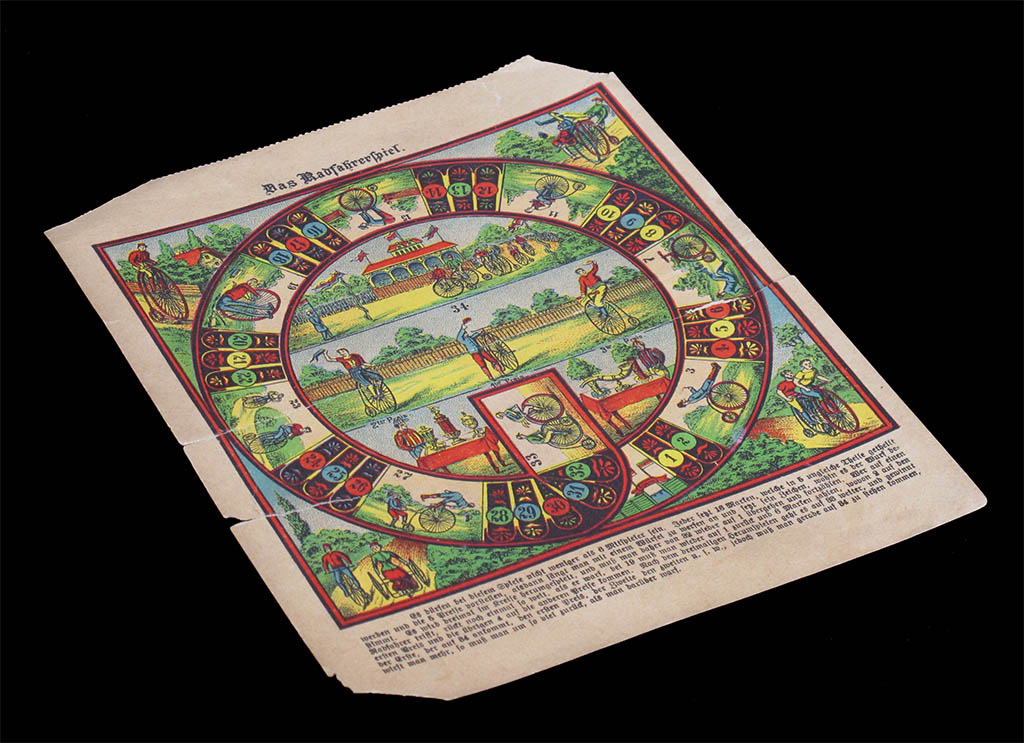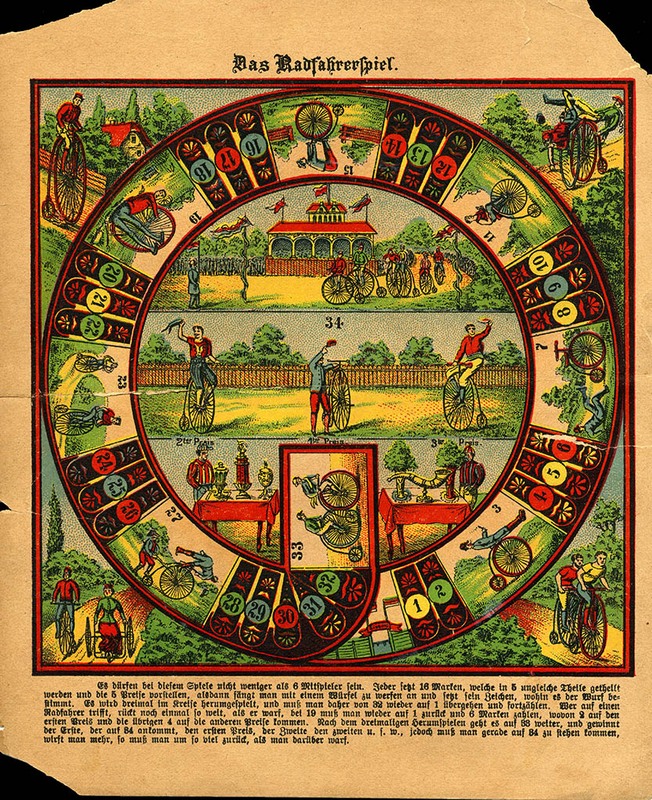
DAS RADFAHRERSPIEL
Germany, 1880s

This game might be the oldest game in my collection so far. It is a small game (20.2 x 16.4 cms) printed on thick paper. I found it with four other similar games (see below) that most surely belong to the same collection. As you can see, there is a perforation on the upper side of the game, which indicates these games were released as a booklet.

There isn't any indication of the maker or the year the games were made on any of them, so I just can guess the age by a couple of facts. The first is that this is not a reproduction of an older board. When you have it in your hands, you feel that the game is over 100 years old. It looks older, for instance, than the small version of the otherwise quite similar game Die Rad-Wettfahrt.
The second fact is that the illustrations of this game feature only High Wheelers and these were progressively replaced by the then called "safety bikes" in the late 1880s.

The rules of the game are hard to read for modern readers since they are printed in the Fraktur type, which can be quite confusing if you are not used to it. (Of course, the fact that my German is rather poor does not help much). However, this does not give an indication about the age of the game since the Fraktur type was used until WWII.
As for the rules, it is a betting game of the goose type, of course, with a few special rules:a) The game has to be played by a minimum of six players. Each player puts 16
markschips as prize money. The total will be distributed unevenly (no more precisions given) between five prizes for the first five players to end the game.b) The players have to complete three laps on the 32-field circular track and only then may attempt to reach the final square, number 34, which only may be reached by an exact throw or else will go backwards some squares, as in most games of goose.
c) Whenever a rider falls on another cyclist, the rider moves again by the same distance (doubles his initial throw).
d) The only special square is number 19. Cyclists who fall on it go back to square one and pay six marks, two of which are added to the first prize and the rest to the other prizes.
With these, I think (*) you can play the game. Scroll to the bottom of the page to download the board.
(*) Please email me if you detect errors in my translation.
UPDATE 2023: Siegfried L. has sent his comments and corrections, for which I am grateful:
(a1) The German rules say "Marken", not "Mark". The old German currency Mark has no plural in the German language (whereas in English it is "marks"). If money was meant, the rules would say "16 Mark". "Marken" (plural of "Marke") can be translated as "counters" or "chips". Another thing is: In the days of the game, 16 marks was a lot of money. The equivalent of 16 German marks in the 1880s would be 120 euros today, but, at the turn of the century, 16 marks was the weekly wage of a harbour worker in Hamburg (there was almost no inflation then). Only a few people would have risked so much money on a game of dice. Therefore, I'm sure in this game counters or chips have been used (into which money could have been changed if one really intended to play for money).(a2) A more precise translation of the German text "Jeder setzt 16 Marken, welche in fünf ungleiche Teile geteilt werden..." would be: "Each player gives 16 counters, which are divided into five uneven parts." So literally the 16 counters have to be divided, not the sum. To me this seems to be an arithmetic exercise. ;-) The only solution is: 6 counters for the winner, 4 for the 2nd, 3 for the 3rd, 2 for the 4th, and 1 counter for the 5th. Of course these numbers have to be multiplied by the number of players to get the total amount of the prizes.
(b) The German rules are more precise. The translation of "...muss man gerade auf 34 zu stehen kommen, wirft man mehr, so muß man um so viel zurück, als man darüber warf." is: "You have to reach 34 exactly. If you throw more, you have to go back the same number of squares your throw exceeded the exact number needed."
Of course Siegfried is absolutely right on the first point, and I think we agree on the third point (I just rewrote the sentence, but I guess we say the same). About his interpretation of the uneven distribution of his second remark, I am not really sure. I concede he has a point, but it looks a little strange to me that the rules are not more precise about the distribution, unless it would be obvious to a contemporary reader. Since this is not my case (not contemporary, not even German), I cannot be sure.


I said above that all the velocipedes depicted in the game are of the high-wheel type, but there is an exception. The lady on the bottom right corner of the board rides a tricyce. An 1880s tricycle, by the way.

High Wheelers were also called "Bone Shakers" for a good reason. They were also called Penny-Farthings, or even "Ordinaries" (as opposed to the modern bicycles with two wheels of the same size).

According to Charles Terront's memories, the change from high wheelers to modern bicycles, at least for professional cyclists, was in 1888-1889. Charles Terront himself was quite conservative about it and rode high wheelers as long as possible. In 1888 he won the 100 km French Championship on a high wheeler while his competitors already rode modern bikes. In 1889 he won this title again, but by then he was riding a modern bicycle himself.




The dangers of the High Wheeler.


No wonder it was dangerous!



As I said, there are no modern bikes on this board.
Compare to
this other game,
which is also interesting for bicycle historians.


The prizes for the players.

These are the other games that I found with this one. They are all of the same size and most probably belonged to the same booklet. Unfortunately, their overall condition is not the best. Apart from Das Radfahrerspiel, we find Das neue Affenspiel (the new game of the ape), Das Gansespiel (the game of goose), Jagdspiel-Die Treibjagd (a fox-hunting game), and a nameless sheet with dominoes. Notice that it is a rather unusual double-seven domino game.




XVth Anniversary of the site special present:
Click here to download a hi-res image of this game
(12 Mb JPG file. Suitable to be printed on an A3 or even A2 sheet)
Thanks Stephen for the tip
allowing me to find this game!
|
CULTURE |
TOTUM REVOLUTUM |
NAMES |
CATEGORIES |
WHAT'S NEW |